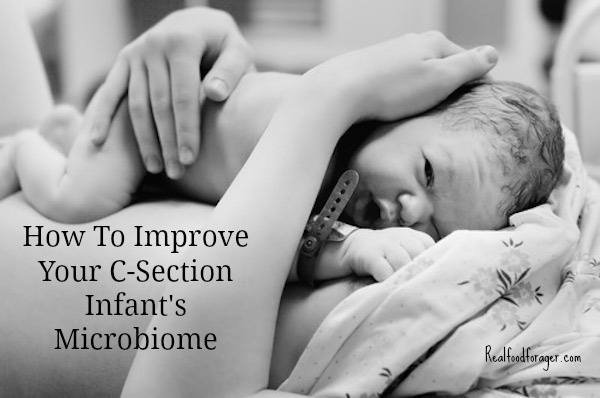
Find out how to improve your c-section infant’s microbiome with a new technique. Now we have a way to correct this important health issue right at birth.
We know that babies born by C-section have less diversity in their microbiome as a result of lack of exposure to the mother’s vaginal flora.
What started as an educated assumption, has now been verified by research. A new study out of New York University, headed by Dominguez-Bello MG, et al, in collaboration with several other U.S.-based groups including Dr. Rob Knight, published in Nature medicine, has shown a benefit to newborns born by C-section, who are swabbed with their mother’s birth fluid.
Mother’s Birth Fluid Contains Beneficial bacteria
Babies born by vaginal birth pick up the mother’s microbiota and this begins the seeding of their own microbiome. C-section babies do not go through the birth canal and so are not exposed to these microbes.
We know that many immune diseases are now associated with imbalances in the gut bacteria and this can start at birth. Conditions such as asthma, allergies, autoimmunity, obesity and autism can start with disruption of the microbiome.
Up to 1/3 of babies born today are born via C-section (much of the time this is not necessary). Sadly, these babies are being set up for immune disorders and chronic conditions, as C-section delivery has been associated with increased risk for immune and metabolic disorders.
In this study, researchers swabbed the mouth of infants with a gauze previously placed in the women’s vaginas. They found that the babies born vaginally and those babies who received the swabbing had increased levels of beneficial bacteria, including lactobacillus and bacteroides in the gut, oral and skin bacterial communities.
The C-section babies that were treated with the swabbing were compared to other C-section babies who were not treated and these unexposed babies’ bacteria were found to be “underrepresented.”
This study is a pilot study and the researchers end with the statement that more studies are needed to confirm the findings. They further conclude that,
Although the long-term health consequences of restoring the microbiota of C-section-delivered infants remain unclear, our results demonstrate that vaginal microbes can be partially restored at birth in C-section-delivered babies.
This idea was originally introduced by Dr. Rob Knight, one of the top researchers in the microbiome today. He actually had an emergency C-section baby in 2012. Knowing what he knows about the critical importance of the microbiome starting from birth – he and his wife took it upon themselves to swab their baby with the mother’s vaginal fluids.
He then wanted to investigate with the scientific community if this, in fact, improved the microbiome of C-section babies.
Infants Receive Beneficial Bacteria via Vaginal Birth
Vaginal births expose babies with a coating of vaginal and fecal bacteria. While it may take some getting used to – this coating protects them from harmful bacteria that cause illness.
Birth is the starting point of colonization of the baby’s microbiome from the mother. Breastfeeding is another way babies get mother’s microbes.
Interestingly, the baby’s guts are colonized by bacteria that help the baby to digest milk and educate its developing immune system as to what is self and what is foreign. This allows for a normally developing immune system.
In contrast, babies born by C-section pick up the skin bacteria (different from vagina and gut) from anyone around them including medical staff and hospital bacteria such as Clostridium difficile (C.diff) and Pseudomonas (not good).
It appears that C-section babies are more prone to infections in the first weeks of life. Additionally C-section babies are at increased risk of developing allergies and autoimmune diseases, and becoming overweight.
Studies also show that the western baby gut microbiome is too clean.
We need to prevent this insufficient start in life for these babies.
Just think, after a few more confirmation studies, we could see vaginal swabbing initiated as a standard procedure in hospitals to ensure the critical inheritance of beneficial microbes that come with natural birth.
Or, until then, you could do this on your own when the doctors leave the room.
What would you do if you have to have a C-section birth? Leave a comment and let me know!
If you are as fascinated by the new research on the microbiome and how that affects your health and the health of your family, you may be interested in a diet that supports your microbiome!
Start now.
Start by receiving my Getting Started series to start you real food journey! Get them here!
Check out my e-book, Heal Your Microbiome Optimize Your Health! It’s on sale today!
Original article and pictures take realfoodforager.com site
Комментариев нет:
Отправить комментарий